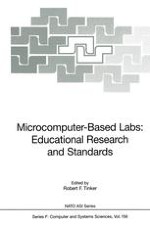
1996 | OriginalPaper | Buchkapitel
Introdution
verfasst von : Robert F. Tinker
Erschienen in: Microcomputer–Based Labs: Educational Research and Standards
Verlag: Springer Berlin Heidelberg
Enthalten in: Professional Book Archive
Aktivieren Sie unsere intelligente Suche, um passende Fachinhalte oder Patente zu finden.
Wählen Sie Textabschnitte aus um mit Künstlicher Intelligenz passenden Patente zu finden. powered by
Markieren Sie Textabschnitte, um KI-gestützt weitere passende Inhalte zu finden. powered by
The idea of computers in the lab is nothing new to scientists. Almost all research has come to rely on computers to control experiments, to collect data, to represent the data in visual forms such as graphs, and to extract trends and summary information from the sometimes huge amounts of data. In addition, the same computers are often used to explore mathematical models and compare these models to the observed data. The importance of doing this in the lab as the experiment is underway — in “real time” — has obvious advantages for repeating suspect results or quickly following up unexpected leads. In fact, the first personal computer may have been the 1960’s era Digital Equipment Corporation’s PDP-8L, where the “L” indicates that it was optimized for laboratory use in recognition of the importance of having realtime data acquisition and analysis capacity in the lab. Many of the first users of this capacity were experimental physicists who tended to be quite comfortable with the use of electronics, sensors, and instruments in their research.